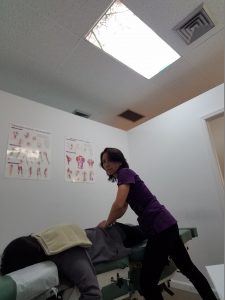
Approximately 80% of adults will have low back pain at some time in their lives. Furthermore, it appears that adolescents with low back pain are more likely to have problems as adults. Above all, chiropractic treatment is a valuable treatment associated with clinical improvement for acute and chronic low back pain for all ages (infants to seniors).
Read on to learn about 3 Causes of Low Back Pain a Chiropractor Can Help With.
-
Sacroiliac Sprain
The sacroiliac joint is located in the pelvis. You have 2 sacroiliac joints (left and right). It links the iliac bones (pelvis) to the sacrum (lowest part of the spine above the tailbone).
A sprain is an injury (micro tears) to the ligaments around a joint. Ligaments are strong, flexible fibers that hold bones together. With a sacroiliac sprain, you may have pain over the joint(s). The pain is often sharp and stabbing and may radiate down the back of the leg. You may have relief somewhat by sitting or lying.
Importantly, adjusting (chiropractic manipulative therapy) of the sacroiliac joints should be performed gently, to avoid increased stretch to the sacroiliac ligaments.
Cause
Certainly, the sacroiliac ligamentous support of the sacroiliac joint is strong. Nevertheless, injury can occur from prolonged or sudden lifting of an object or bending.
An evaluation for seronegative arthritides (i.e., ankylosing spondylitis or psoriatic) may be done in case of an underlying complication in unremitting or recurring cases. For instance, elbow or scalp skin lesions (e.g. dry itchy rash) suggests psoriatic arthritis. X-rays may help with the diagnosis.
-
Sacroiliac Subluxation
So in the chiropractic office, we see many sacroiliac joint subluxations (chiropractic joint misaligments/intersegmental dysfunctions) in addition to sprains. Subsequently, sacroiliac dysfunction probably accounts for almost half the cases of low back pain. With a sacroiliac subluxation, the pain is often sharp and stabbing.
Cause
Firstly, as a sacroiliac sprain, prolonged or sudden lifting or bending may also cause a sacroiliac subluxation. It may also be due to incorrect ergonomics/posture.
Secondly, sacroiliac joint innervation (supply with nerves) is from a broad area including both sacral levels S1-S2 (between low back and tailbone) and lumbar levels L1-L3 (low back) plexuses (network of nerves). This may explain the varied pain patterns with sacroiliac joint involvement. The varied pain patterns can be low back, buttock, lower extremity (leg) and groin pain.
Thirdly, the chiropractic subluxation presents with reduced joint motion and alignment which is corrected by the chiropractic adjustment. Spinal or extremity (arms and legs) joint dysfunction/ subluxation (chiropractic subluxation complex), can adversely affect nerve function, and the body’s ability to regulate and maintain health. Chiropractic adjustments address disturbed joint biomechanics and the associated effects on nervous system function.
Lastly, both sacroiliac sprains and sacroiliac joint dysfunction/pain affect the majority of adult patient population. However, there are some peaks of increased occurrence in younger adults following sporting injury, pregnancy and older adults from degeneration.
-
Piriformis Syndrome
The piriformis is a flat, pear-shaped muscle located in the gluteal (buttock) region of the hip/proximal thigh. You will have buttock and posterior (back of ) leg pain without any trauma.
Cause
The sciatic nerve runs under the piriformis muscle where it may be compressed (pinched) by the piriformis muscle. As the biggest nerve in your body, it originates from several nerves in your lower back. These nerves branch outward from the spine and then come together at each buttock to form the sciatic nerve, which then travels down each leg.
Predisposition to piriformis syndrome may be due to an anatomically short leg (one leg is structurally shorter than the other due to bone length differences). Other reasons could be due to excessive pronation (inward rotation of foot) of your foot or a pelvic rotation/misalignment.
Postisometric relaxation techniques or myofascial release soft tissue techniques to the piriformis muscle is important along with the chiropractic manipulative therapy for treatment of piriformis syndrome.

At Meiri Chiropractic, we spend the time necessary to examine, diagnose and treat every neuromusculoskeletal condition and various ailments you have. Chiropractic is a holistic and natural way to not only treat low back pain, but to keep your body in its best working condition. We have been offering effective chiropractic care in Palm Beach County since 2006. Many of our patients reviews note our excellence. We are your best bet and are here for you. Call us today at 561-253-8984 to make an appointment or to find out more about 3 Causes of Low Back Pain a Chiropractor Can Help With.
References:
Thomas Souza, (2018) Differential Diagnosis and Management for the Chiropractor